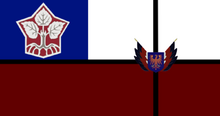Nowosorby
This article has multiple issues. Please help improve it or discuss these issues on the talk page.
|
Duchy of Nowosorby | |
|---|---|
| Motto: Nowosorbian: "Přez krej, wo zjednoćić!" English: "Through blood, we unite!" | |
| Anthem: "Sława Nowosorby" | |
[[File:Sporadic locations in the Midwestern North America  | |
| Capital | None; Disorganized Tribal Settlements |
| Official languages | Nowosorbian, Upper Sorbian, Lower Sorbian, English |
| Demonym(s) | Nowosorbian |
| Government | Tribal Monarchy |
• Wójwoda | Duke Dalibor I Vladimir |
• Wójwodka | Vacant |
| Legislature | Ležownosćerka Rada |
| Hrabja Legislatiwa | |
| Kmjenowy Legislatiwa | |
| Establishment | August 24, 2022 |
| Currency | US Dollar, Nowosorbian Złoty |
Website Government Website | |
The Duchy of Nowosorby, also commonly referred as Nowosorby, is a micronation located in the Midwestern and Southern portion of North America. Its founding was on August 24 in 2022. Though Nowosorby's history is short, the history of its people is rich and spans over a millennium. Nowosorby has a Sorbian culture, which is native to Lusatia, a region in Central Europe. The official religion in Nowosorby is Lutheranism, which was brought along with the Sorbian immigrants to America.
Etymology
The etymology of Nowosorby is derived from the Polish prefix Nowo- and the Nowosorbian word for Sorbia, Sorby.
History
Early History
Nowosorby was founded by Dalibor I Vladimir (Legal Name: Adek Vladimir Dalibor) on August 24, 2022. Though Nowosorby's history is relatively new, the history of the Sorbs go back all the way to the Medieval Era. Sorbs were located on the River Elbe before 600 AD. Little is known about their origins, but it is acknowledged that they are closely related to Czechs, Poles and theoretically, Serbs. Sorbs joined the Slavic tribal federation after a decisive victory won by a nation known as Samo's Empire, which spanned from Slovakia to Lusatia. It is unknown what happened after the collapse of Samo's Empire, though it is most likely that the tribes fragmented into their own small groups, also known as Milceni and Lusici. These two tribes later developed their own dialects, known as Upper and Lower Sorbian.

The first significant clash between the Sorbs and Germans was when Duke Miliduch fought and died in 806 while fighting the Franks. In 840, Duke Czimislav was killed. The years after that remained relatively stable until 932, when Henry I invaded Lusatia and Milsko. The Margrave of Saxon Ostmark reconquered Lusatia the year after, and in 939, murdered 30 Sorbian princes during a feast. After that, the Germans faced heavy resistance and uprisings from the local Sorbian population. In 1018, Lusatia was handed over to Poland after several Polish-German wars, but was handed back in 1031.

Modern History
Between 1376 and 1635 Lusatia was part of Bohemia, under the rule of the Luxembourgs, Habsburgs and other kings. From the beginning of the 16th century the whole Sorbian-inhabited area, with the exception of Lusatia, underwent Germanization. In 1635 Lusatia became a fiefdom of Saxon electors, but it retained a considerable autonomy and largely its own legal system. The Thirty Years' War and the plague during the 17th Century caused terrible devastation in Lusatia. This led to further German colonization and Germanization. The Congress of Vienna, in 1815, gave part of Upper Lusatia to Saxony, but most of Lusatia to Prussia. More and more bans on the use of Sorbian languages appeared from then until 1835 in Saxony and Prussia; emigration of the Sorbs, mainly to the town of Serbin in Texas. increased. Additionally, the German influx of immigrants in the late-half of the 19th century brought more Sorbs who were heavily Germanized to the East Coast and Midwest. Nowosorby was formed by a descendant of Sorbian heritage, Dalibor I Vladimir, after seeing how the Sorbians were disappearing and how they need a revival of their old culture. Not only does Nowosorby exist as a settlement for Sorbs, but also sees itself as the Government-in-exile of Lusatia.[1]

Government
Politics
The political system of Nowosorby is modeled after the system of Medieval Slavic Nations, having an inherited Duke with full control over the lands of the nation, along with smaller, localized Landowners who govern over settlements. Not only is it based on Slavic Tribes, but also a hybrid of Feudalism. The way it is similar to Feudalism is due to the idea of Counts (or Hrabja) having control of titles under a Duke (Wójwoda) or Duchess (Wójwodka)
Legislation
The Ležownosćerka Rada (Legislative Council) is the collective term for Legislation in Nowosorby. The Upper House, Hrabja Legislatiwa (Count Legislation), is the legislative sub-council which is under the leadership of Counts. Kmjenowy Legislatiwa (Tribal Legislation) is the legislative sub-council with its leadership comprised of Tribal Leaders, which are representatives of townships in Nowosorby.
House of Łużywojnik
The House of Łužywojnik are the ruling dynasty of the Duchy of Nowosorby. Founded in 2022, the House of Łužywojnik is descended from multiple Royal Houses through genealogical research, such as the Rurikids, Piasts, Árpáds, Plantagenets, and Dobromir of Lusatia. The Łužywojniks are a mix of Sorbian, Polish, English, and German ethnicities.

References
- ↑ 18 Sep 2022 Announcement of the Government-in-exile of Lusatia: Taking into consideration that Lusatia is not independent, along with Nowsorby being the only known Sorbian nation, Nowosorby has created the title of Government-in-exile of Lusatia. With this in mind, we are hoping to gain international recognition and appeal to the German government for an autonomous or independent Lusatia.

